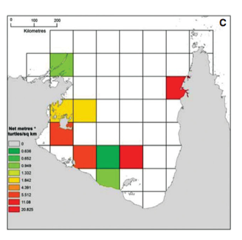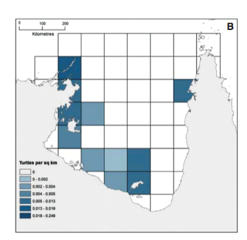Ghostnets: marine debris is “ghostfishing”
by Emily Rose Nelson, RJD Intern
Annually 640,000 tons of fishing gear is lost, abandoned, or discarded at sea. This deserted fishing gear is known as “ghostnets” and has the potential to “ghostfish” by itself for decades. Ghostnets are a growing issue due to their ability to trap and kill large quantities of commercially valuable fish and threatened species, leading to a loss in food and biodiversity. This waste is of even more concern than other types of marine debris because it is developed specifically to catch marine organisms, often leading to their death.
It is clear there is a lot of trash in the oceans, however little is known about where debris occurs and what organisms it is interacting with. In order to address the problems resulting from ghostnets it is necessary to answer these questions. A team of researchers in Australia set out to understand some of the impacts abandoned fishing gear could have on biodiversity. By combining physical and ecological approaches they were able to predict entanglement risk (expected interactions between nets and turtles) of marine turtles in the Gulf of Carpentaria (GOC) region of Australia.
5,491 ghostnets were collected from the beaches around the GOC area during a large scale coastal clean up. These were analyzed to determine species impacted and estimate ghostnet distribution. Of the species caught over 80% were marine turtles, thus providing the focus for the study. Using trawl records to estimate turtle distribution at sea, physical models of ocean current to create potential paths of nets, and beach clean up data encounter rates were predicted by analyzing spatial overlap. Entanglement risk was found to be concentrated in one area along the eastern margin of the GOC and a wide section along the southwest GOC. Observed entanglements correlate with the encounters predicted using this model, suggesting that previous encounters can be used as a measure of risk. This also shows that entanglement is driven by the frequency turtles encounter debris and not increased foraging behavior.

Predicted entanglement risk to turtles in the GOC based on relative turtle density and ghost fishing efforts.
The approach taken in this study has broad applications to other marine systems and is expandable to a global scale for a number of organisms. Over 200 species have known interactions with marine debris. Expanding this model of marine debris density and combining it with species distribution data opens the door to analyze encounter rates to for a number of species. This could potentially identify global hot spots for interaction with ghostnets, helping to understand the impacts and provide solutions. Identifying high-risk areas will help focus efforts to reduce impacts of ghostnets.
There are a number of more direct actions to take in addressing ghostnets. Using information used from models of their circulation paths the nets can be monitored using aerial and satellite surveys. Coastal surveillance programs can incorporate those areas most heavily affected. Another option would be to create management that provides incentive to return all gear. Buyback programs have worked successfully in some areas, however this requires a great deal of time and money.
REFERENCES
Wilcox, C., B. D. Hardesty, R. Sharples, D. A. Griffin, T. J. Lawson, and R. Gunn “Ghostnet Impacts on Globally Threatened Turtles, a Spatial Risk Analysis for Northern Austrailia.” Conservation Letters (2013): 247-54. Print.





What is the source of the estimate of annual gear loss (640,000 tones) from fishing activities in the ocean?
Macfayden, G., Huntington, T. & Cappell, R. (2009).
Abandoned, lost or otherwise discarded fishing gear. UNEP
Regional Seas Reports and Studies, No. 185; FAO Fisheries
and Aquaculture Technical Paper, No. 523. Rome,
UNEP/FAO. 115 pp